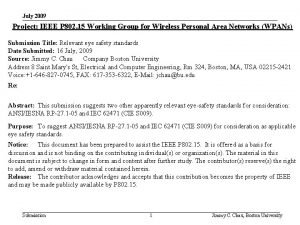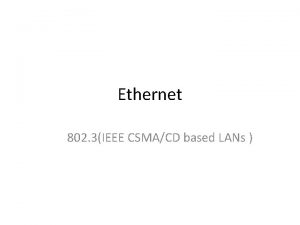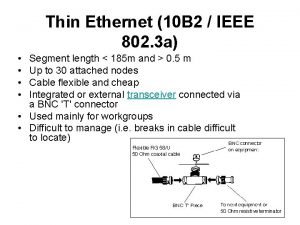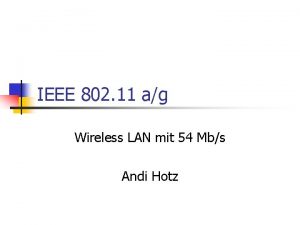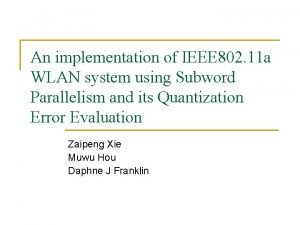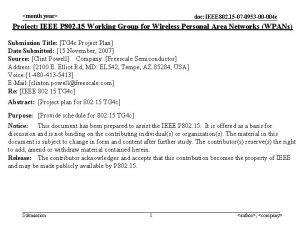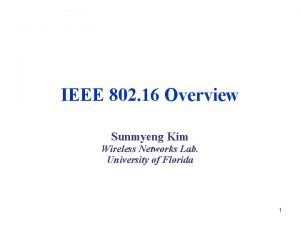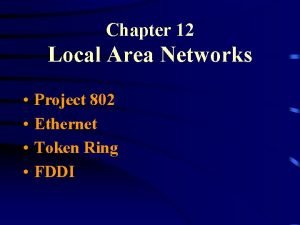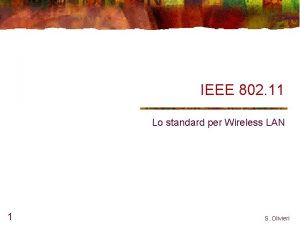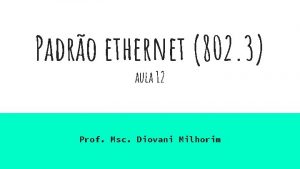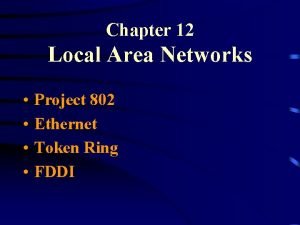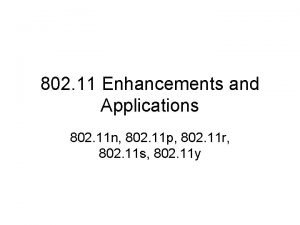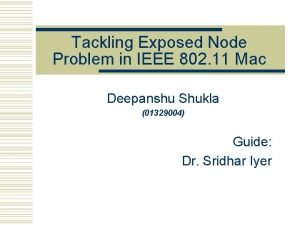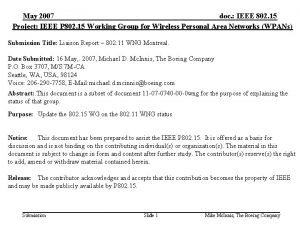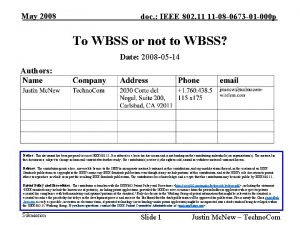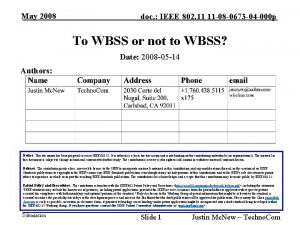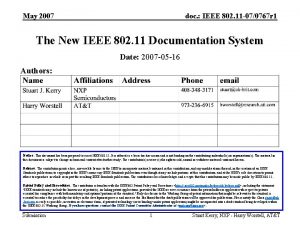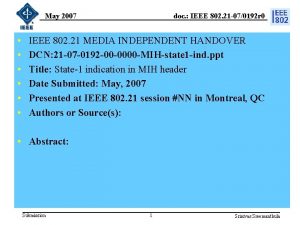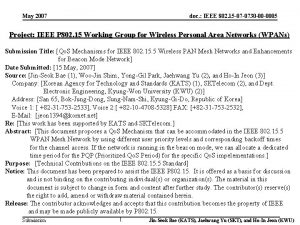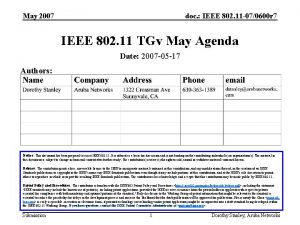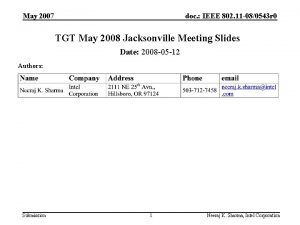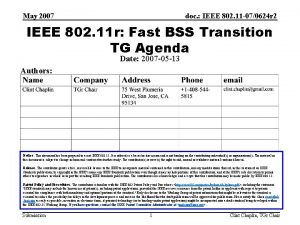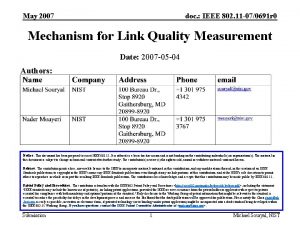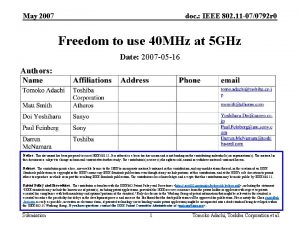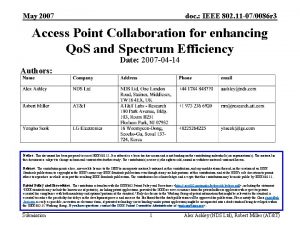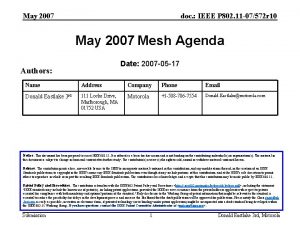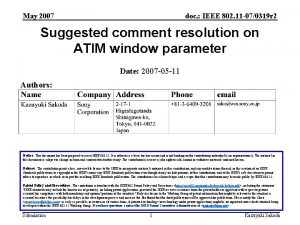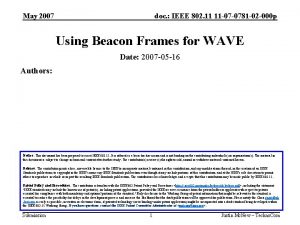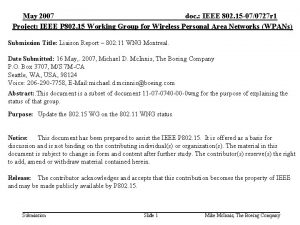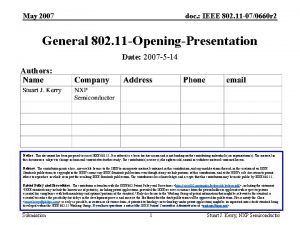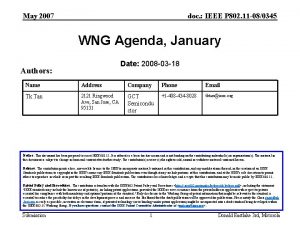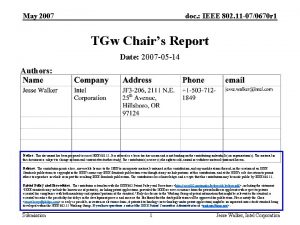May 2007 doc IEEE 802 11 070468 r



























- Slides: 27

May 2007 doc: IEEE 802. 11 -07/0468 r 1 Preferred Channel and DFS Authors: Name Company Address Phone email Joe Kwak Inter. Digital Bolingbrook, IL 630 -739 -4159 joekwak@sbcglobal. net Jari Jokela Nokia Visiokatu 1, 33720 Tampere, Finland +358 50 486 0445 Jari. jokela@nokia. com Roger Durand RIM rdurand@rim. com Notice: This document has been prepared to assist IEEE 802. 11. It is offered as a basis for discussion and is not binding on the contributing individual(s) or organization(s). The material in this document is subject to change in form and content after further study. The contributor(s) reserve(s) the right to add, amend or withdraw material contained herein. Release: The contributor grants a free, irrevocable license to the IEEE to incorporate material contained in this contribution, and any modifications thereof, in the creation of an IEEE Standards publication; to copyright in the IEEE’s name any IEEE Standards publication even though it may include portions of this contribution; and at the IEEE’s sole discretion to permit others to reproduce in whole or in part the resulting IEEE Standards publication. The contributor also acknowledges and accepts that this contribution may be made public by IEEE 802. 11. Patent Policy and Procedures: The contributor is familiar with the IEEE 802 Patent Policy and Procedures <http: // ieee 802. org/guides/bylaws/sb-bylaws. pdf>, including the statement "IEEE standards may include the known use of patent(s), including patent applications, provided the IEEE receives assurance from the patent holder or applicant with respect to patents essential for compliance with both mandatory and optional portions of the standard. " Early disclosure to the Working Group of patent information that might be relevant to the standard is essential to reduce the possibility for delays in the development process and increase the likelihood that the draft publication will be approved for publication. Please notify the Chair <stuart. kerry@philips. com> as early as possible, in written or electronic form, if patented technology (or technology under patent application) might be incorporated into a draft standard being developed within the IEEE 802. 11 Working Group. If you have questions, contact the IEEE Patent Committee Administrator at <patcom@ieee. org>. Submission 1 Joe Kwak, Jokela, Durand

May 2007 doc: IEEE 802. 11 -07/0468 r 1 OUTLINE n n n n n Introduction Power Saving Benefits Deffered Channel Operation DFS Regulations ETSI’s Compliant DFS Specification Preferred Channel Specification Comparison of Compliant vs Preferred Channel specifications wrt regulations Uniform Spreading requirement details Conclusions Submission 2 Joe Kwak, Jokela, Durand

May 2007 doc: IEEE 802. 11 -07/0468 r 1 Introduction n n n Use of Preferred Channel for STAs searching for APs for association saves 80% of battery power. NOV 06 (06/956 r 2) meeting held straw poll for support of Preferred Channel with an AP control instead of distributed control showing 92% support. JAN 06 (07/120 r 0) meeting presented Preferred Channel with AP control. Vote to incorporate normative text showed only 45% support due to concerns about DFS compliance. MAR 06 meeting presented text changes fully complying with DFS. Vote still showed only xx% support, several commenters still objected on regulatory grounds. Later discussion revealed that real reason was observation most APs available for the DFS markets are not capable of complying with the requirements in the normative text. This presentation shows modified normative text making AP capability for Preferred Channel a PICS option. Submission 3 Joe Kwak, Jokela, Durand

May 2007 doc: IEEE 802. 11 -07/0468 r 1 Power Savings for Network Discovery n n n Power savings is obtained by reducing number of scanned channels when searching for available BSS when STA is not connected to any network. Power savings of 80 -85% is guaranteed no matter what scanning mode or scanning period is used by the STA. APs monitor Preferred Channel for the operating Regulatory Class and ensure that Preferred Channel is active. STAs which passively scan a Preferred Channel and detect no activity need not scan any other channels in that Regulatory Class. For mobile STAs out of radio range of any WLAN, network discovery is the only STA task and consumes 100% of the terminal's power. For these STAs, power savings is very significant and can multiply standby time by a factor of 5 !! Submission 4 Joe Kwak, Jokela, Durand

May 2007 doc: IEEE 802. 11 -07/0468 r 1 Preferred Channel Power Savings for 2. 4 GHz n n n Only scan 1 channel per defined channel set. In USA or Europe need to scan only 1 channel. In Japan need to scan only 2 channels. If Region is unknown, need to scan only 2 channels Power is saved by scanning only 1 or 2 channels instead of 14, ===> 85% less scanning. Submission 5 Joe Kwak, Jokela, Durand

May 2007 doc: IEEE 802. 11 -07/0468 r 1 Preferred Channel Power Savings for 5 GHz n n n Only scan 1 channel per defined channel set. In USA need to scan only 8 of 41 channels (80% less). In Europe need to scan only 3 of 19 channels (84% less). In Japan need to scan only 7 of 32 channels (78% less). If unknown, need to scan only 15 of 73 channels (80% less). Submission 6 Joe Kwak, Jokela, Durand

May 2007 doc: IEEE 802. 11 -07/0468 r 1 Concept for Preferred Channel n n n One channel in each regulatory class /channel set is defined to be the Preferred Channel is randomly reselected daily for each defined channel set. Preferred Channel procedures insure that there is an active BSS or Network Advice frames transmitted once each beacon period on the Preferred Channel. STAs scan only the Preferred Channels for beacons or network advice frames. Power is saved by not scanning other channels. Submission 7 Joe Kwak, Jokela, Durand

May 2007 doc: IEEE 802. 11 -07/0468 r 1 Wifi Scanning for Dual Mode STAs Cellular Metro Coverage area WIFI Metro Coverage area n n n WIFI covers 10% of cities, 1% of states Most dual mode STAs constantly scanning for Wifi MAJOR Impact on dual mode product standby time Submission 8 Joe Kwak, Jokela, Durand

May 2007 doc: IEEE 802. 11 -07/0468 r 1 Preferred Channel Definition n n Preferred Channel is randomly selected using the same Pseudo Random Number Generator (PRNG) already used in 802. 11 for WEP encryption. Procedure RC 4 is called to generate a random number which selects the Preferred Channel for each day: DATE= YYYY*365 + MM*31 +DD where DDMMYYYY is the current date SEED= DATE*10 E 12 +DATE*10 E 6 +DATE Preferred Channel Order = (call RC 4(SEED, 64))mod. Q where a call to RC 4() returns a random 64 bit number and where Q is the number of channels in a defined channel set § § Preferred Channel Order indicates which channel (first, second, third, etc. ) in the defined channel is the Preferred Channel. This selection method satisfies DFS regulatory requirements. Submission 9 Joe Kwak, Jokela, Durand

May 2007 doc: IEEE 802. 11 -07/0468 r 1 Use of Preferred Channel n n n Preferred channel is favored when selecting channel for BSS operation. Preferred Channel Procedure: 1. AP will select Preferred Channel for operation unless: a. it is already in use b. it is unsuitable based on the AP's channel selection rules c. it has unacceptable interference, or is otherwise unsuitable. 2. AP operating on non-preferred channel shall: a. monitor Preferred Channel for continued activity b. if Preferred Channel is inactive, AP shall transmit or selects STA(s) to transmit Net Advice frames on Preferred Channel 3. Selected STA(s) shall transmit Net Advice on Preferred Channel: n n n Once each beacon period (TBTT) At beacon data rate & at max transmit power Switches to Preferred Channel, transmits and switches back Submission 10 Joe Kwak, Jokela, Durand

May 2007 doc: IEEE 802. 11 -07/0468 r 1 NET ADVICE FRAME n n If no BSS is operating on preferred Channel, Net advice frames are transmitted at the beacon rate and "point to" operating BSS channel. Net Advice always transmitted at lowest rate and highest power. Net Advice frame advertises the operating BSS of the onduty STA: Country, Regulatory Class, and BSS Channel values are for the BSS in which the transmitting STA is associated. Submission 11 Joe Kwak, Jokela, Durand

May 2007 doc: IEEE 802. 11 -07/0468 r 1 Review of Normative Text Changes n n n In 07/0118 r 4: AP procedures split into procedures with DFS and procedures without DFS. PICs modified to indicate AP procedures with DFS is optional. Submission 12 Joe Kwak, Jokela, Durand

May 2007 doc: IEEE 802. 11 -07/0468 r 1 Conclusions n n n Preferred Channel is shown to save 75 -80% power for STAs scanning for Wifi services (07/0120 r 0). Preferred Channel Procedures insure transmissions on Preferred Channel, active BSS or Net Advice frames at beacon rate. Preferred Channel operation with DFS is more complex due to requirement for STA enabling, channel clearing and DFS monitoring. Preferred Channel operation in DFS regulatory classes is optional. STAs with DFS detection capability may evolve to provide STASTA adhocs and mesh operation in DFS markets, enabling greater Preferred Channel operation in DFS regions. Complexity is limited, benefits are great. Submission 13 Joe Kwak, Jokela, Durand

May 2007 doc: IEEE 802. 11 -07/0468 r 1 Motion n n n Move to include 07/0118 r 4 into next version of TGv draft Moved: _Kwak_____ Second: _____ YES NO ABSTAIN Submission _______ 14 Joe Kwak

May 2007 doc: IEEE 802. 11 -07/0468 r 1 DFS Backup Slides Submission 15 Joe Kwak, Jokela, Durand

May 2007 doc: IEEE 802. 11 -07/0468 r 1 European DFS Regulations ”Every WAS/RLAN, when operating in the frequency ranges 5 250– 5 350 MHz and 5 470– 5 725 MHz, shall employ a DFS mechanism with a Radar Interference Detection function to detect radar signals which have a level above the interference detection threshold as defined in Recommendation ITU-R M. 1652. With regard to DFS, a WAS/RLAN device shall operate in either Master or Slave Mode. WAS/RLAN devices operating in Slave Mode (Slave Device) can only operate in a network controlled by a WAS/RLAN device operating in Master Mode (Master Device). Every Master Device will use the Radar Interference Detection function in order to check for any co-channel radar signal prior to use a channel but also during normal operation. In addition to this Radar Interference Detection function, every Master Device shall also implement a channel selection mechanism to ensure a near uniform spread of the loading of available spectrum. The Slave Devices shall not transmit before having received an appropriate enabling signal from a Master Device. Slave Devices with a power level of 200 m. W e. i. r. p. or above shall have their own Radar Interference Detection function. ” Verbatim from Decision ECC/DEC/(04)08, 12 NOV 04, Equiv to FCC ruling. DFS Regulation Submission Uniform Spreading Requlation 16 Joe Kwak, Jokela, Durand

May 2007 doc: IEEE 802. 11 -07/0468 r 1 DFS Master Requirements (EN 301 893) n n n “a) The master device shall use a Radar Interference Detection function in order to detect radar signals. b) Before initiating a network on a channel, which has not been identified as an Available Channel, the master device shall perform a Channel Availability Check to ensure that there is no radar operating on the channel. c) During normal operation, the master device shall monitor the O perating Channel (In-Service Monitoring) to ensure that there is no radar operating on the channel. d) If the master device has detected a radar signal during In-Service Monitoring, the Operating Channel is made unavailable. The master device shall instruct all its associated slave devices to stop transmitting on this (to become unavailable) channel. e) The master device shall not resume any transmissions on this Unavailable Channel during a period of time after a radar signal was detected. This period is referred as the Non-Occupancy Period. ” Submission 17 Joe Kwak, Jokela, Durand

May 2007 doc: IEEE 802. 11 -07/0468 r 1 DFS Slave Requirements (EN 301 893) n n n “a) A slave device shall not transmit before receiving an appropriate enabling signal from a master device. b) A slave device shall stop all its transmissions whenever instructed by a master device to which it is associated. The device shall not resume any transmissions until it has again received an appropriate enabling signal from a master device. c) A slave device which is required to perform radar detection (see table D. 3), shall stop its own transmissions if it has detected a radar” Submission 18 Joe Kwak, Jokela, Durand

May 2007 doc: IEEE 802. 11 -07/0468 r 1 Uniform Spreading Requirements (EN 301 893) n n n “Definition: The Uniform Spreading is a mechanism to be used by the RLAN to provide, on aggregate, a uniform loading of the spectrum across all devices. This requires that a RLAN device shall select a channel out of the list of usable channels so that the probability of selecting a given channel shall be the same for all channels. The probability of selecting each of the usable channels shall be within 10 % of theoretical probability. For n channels, theoretical probability is 1/n. ” Submission 19 Joe Kwak, Jokela, Durand

May 2007 doc: IEEE 802. 11 -07/0468 r 1 ETSI’s Compliant Requirements Summary 1. Master/Slave enabling of transmissions 2. Radar detection for channel availability check 3. Continuous radar detection to monitor operating channel 4. Uniform Spreading for channel selection 5. Shutdown if radar detected (=channel switch). Items in RED apply to Preferred Channel, last requirement already satisfied by TGh Channel Switch. Submission 20 Joe Kwak, Jokela, Durand

May 2007 doc: IEEE 802. 11 -07/0468 r 1 1. Master/Slave Enabling § § § Preferred Channel is designed for AP to control STA transmissions by set/reset of Network. Advice. Enabled bit. No STA shall transmit on Preferred Channel unless so enabled by AP which sets Network. Advice. Enabled bit. This is eqivalent to ETSI requirement sufficient for regulatory purposes. Submission 21 Joe Kwak, Jokela, Durand

May 2007 doc: IEEE 802. 11 -07/0468 r 1 2. Radar Detection for Channel Availability Explicit requirement in new normative text: “If dot 11 Spectrum. Management. Required is true, . . the AP shall periodically monitor the Preferred Channel for frame transmissions. If no beacons and no network advice frames are detected on the Preferred Channel, the AP should perform a channel availability check on the Preferred Channel to ensure that there is no radar operating on the channel. ” n “Should” is used because the AP may not have the resources to detect radar on 2 channels. n Preferred Channel uses same wording as ETSI. n Submission 22 Joe Kwak, Jokela, Durand

May 2007 doc: IEEE 802. 11 -07/0468 r 1 3. Radar Detection for Monitoring Preferred Channel n n Explicit requirement in new normative text: “If an AP has set dot 11 Network. Advice. Enabled to true at any STA, the AP shall ensure that a STA shall use radar interference detection to monitor the Preferred Channel for radar per the regulatory requirements. ” Preferred Channel uses same wording as ETSI. Submission 23 Joe Kwak, Jokela, Durand

May 2007 doc: IEEE 802. 11 -07/0468 r 1 4. Uniform Spreading for channel selection required § § § Regulation requires “channel selection mechanism to ensure a near uniform spread. ” In practice this is accomplished simply by randomly selecting an operating channel. The Regulation does not specify when the random channel number is selected or how often the channel is to be reselected, nor does it address the source of the required random selection or the restrictions on who may use the selected channel. The goal is to provide “near uniform spread”. Random selection is ETSI’s chosen requirement mechanism to satisfy the regulation, others exist. Preferred Channel is randomly selected and satisfies the spirit and letter of the regulation. Submission 24 Joe Kwak, Jokela, Durand

May 2007 doc: IEEE 802. 11 -07/0468 r 1 Uniform Spreading trials with Preferred Channel All channels randomly selected before use. Without Preferred Channel time 1 BSS chan With Preferred Channel 1 2 3 4 5 6 7 8 chan 1 2 3 4 5 6 7 8 1 2 3 4 5 6 7 8 chan 1 2 3 4 5 6 7 8 +1 BSS chan BSS = 40 -70% utilization (typ) Submission P. C. = 1 - 5% utilization (typ) 25 Joe Kwak, Jokela, Durand

May 2007 doc: IEEE 802. 11 -07/0468 r 1 Results from Spreading Trials § § Use of Preferred Channel produces spectrum spreads no less uniform (and possibly more uniform) than currently permitted applications. Worst case for non-uniform spread occurs with a single BSS in the regulatory class. In this case using the Preferred Channel produces a spread more uniform than conventional operation since usually occupies two channels instead of one. All operating channels shall defer and shut down for radar. The Preferred Channel does this, but further defers and shuts down for beacons, thus making the Preferred Channel “available” for all users, according to the current terms and definitions. Submission 26 Joe Kwak, Jokela, Durand

May 2007 doc: IEEE 802. 11 -07/0468 r 1 STRAW POLL n n Do you support use of Preferred Channel for Power Saving? YES NO ABSTAIN Submission _______ 27 Joe Kwak, Jokela, Durand
 Bridges from 802.x to 802.y
Bridges from 802.x to 802.y Bridges from 802.x to 802.y
Bridges from 802.x to 802.y Ieee 802 standard
Ieee 802 standard Ieee 802 bluetooth
Ieee 802 bluetooth 802 ieee
802 ieee Ieee 802
Ieee 802 Ieee 802 family
Ieee 802 family Ieee 802 3 compliance
Ieee 802 3 compliance Wlan standards
Wlan standards Arquitetura ieee 802
Arquitetura ieee 802 Modelo ieee 802
Modelo ieee 802 Hci patterns
Hci patterns Ccna 640-802
Ccna 640-802 09 802 0561
09 802 0561 Ethernet 802
Ethernet 802 802-3-ethernet
802-3-ethernet Ssin-802
Ssin-802 Lan 701
Lan 701 Wireless lan 802
Wireless lan 802 Wlan 802
Wlan 802 802 15
802 15 Modulation coding scheme
Modulation coding scheme What is project 802
What is project 802 802/11
802/11 802 3
802 3 Project 802
Project 802 802 11 n
802 11 n Node 802
Node 802













